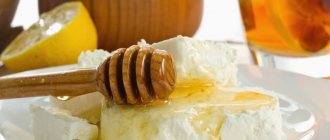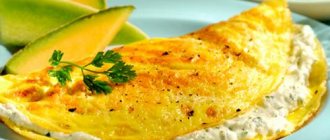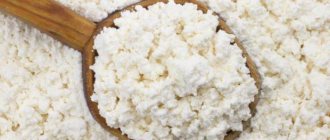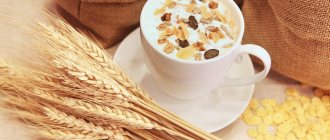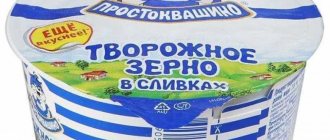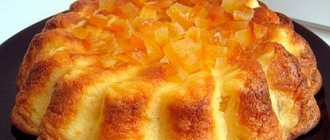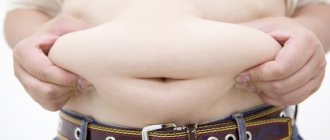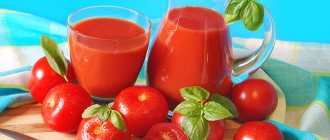Calorie content Low-fat cottage cheese. Chemical composition and nutritional value.
Nutritional value and chemical composition of “Low-fat cottage cheese”.
The table shows the nutritional content (calories, proteins, fats, carbohydrates, vitamins and minerals) per 100 grams of edible portion.
| Nutrient | Quantity | Norm** | % of the norm in 100 g | % of the norm in 100 kcal | 100% normal |
| Calorie content | 79 kcal | 1684 kcal | 4.7% | 5.9% | 2132 g |
| Squirrels | 18 g | 76 g | 23.7% | 30% | 422 g |
| Carbohydrates | 1.8 g | 219 g | 0.8% | 1% | 12167 g |
| Water | 82.48 g | 2273 g | 3.6% | 4.6% | 2756 g |
| Ash | 1.39 g | ~ | |||
| Vitamins | |||||
| Vitamin A, RE | 11 mcg | 900 mcg | 1.2% | 1.5% | 8182 g |
| Retinol | 0.011 mg | ~ | |||
| beta carotene | 0.003 mg | 5 mg | 0.1% | 0.1% | 166667 g |
| Vitamin B1, thiamine | 0.021 mg | 1.5 mg | 1.4% | 1.8% | 7143 g |
| Vitamin B2, riboflavin | 0.165 mg | 1.8 mg | 9.2% | 11.6% | 1091 g |
| Vitamin B4, choline | 17.5 mg | 500 mg | 3.5% | 4.4% | 2857 g |
| Vitamin B5, pantothenic | 0.215 mg | 5 mg | 4.3% | 5.4% | 2326 g |
| Vitamin B6, pyridoxine | 0.068 mg | 2 mg | 3.4% | 4.3% | 2941 g |
| Vitamin B9, folates | 12 mcg | 400 mcg | 3% | 3.8% | 3333 g |
| Vitamin B12, cobalamin | 0.63 mcg | 3 mcg | 21% | 26.6% | 476 g |
| Vitamin E, alpha tocopherol, TE | 0.01 mg | 15 mg | 0.1% | 0.1% | 150000 g |
| Vitamin K, phylloquinone | 0.1 mcg | 120 mcg | 0.1% | 0.1% | 120000 g |
| Vitamin RR, NE | 0.128 mg | 20 mg | 0.6% | 0.8% | 15625 g |
| Macronutrients | |||||
| Potassium, K | 86 mg | 2500 mg | 3.4% | 4.3% | 2907 g |
| Calcium, Ca | 61 mg | 1000 mg | 6.1% | 7.7% | 1639 g |
| Magnesium, Mg | 5 mg | 400 mg | 1.3% | 1.6% | 8000 g |
| Sodium, Na | 406 mg | 1300 mg | 31.2% | 39.5% | 320 g |
| Sera, S | 123.9 mg | 1000 mg | 12.4% | 15.7% | 807 g |
| Phosphorus, Ph | 134 mg | 800 mg | 16.8% | 21.3% | 597 g |
| Microelements | |||||
| Iron, Fe | 0.14 mg | 18 mg | 0.8% | 1% | 12857 g |
| Manganese, Mn | 0.003 mg | 2 mg | 0.2% | 0.3% | 66667 g |
| Copper, Cu | 28 mcg | 1000 mcg | 2.8% | 3.5% | 3571 g |
| Selenium, Se | 9 mcg | 55 mcg | 16.4% | 20.8% | 611 g |
| Fluorine, F | 31.6 mcg | 4000 mcg | 0.8% | 1% | 12658 g |
| Zinc, Zn | 0.38 mg | 12 mg | 3.2% | 4.1% | 3158 g |
| Digestible carbohydrates | |||||
| Mono- and disaccharides (sugars) | 2.72 g | max 100 g | |||
| Essential amino acids | |||||
| Arginine* | 0.565 g | ~ | |||
| Valin | 0.767 g | ~ | |||
| Histidine* | 0.412 g | ~ | |||
| Isoleucine | 0.728 g | ~ | |||
| Leucine | 1.274 g | ~ | |||
| Lysine | 1.002 g | ~ | |||
| Methionine | 0.373 g | ~ | |||
| Threonine | 0.55 g | ~ | |||
| Tryptophan | 0.138 g | ~ | |||
| Phenylalanine | 0.668 g | ~ | |||
| Nonessential amino acids | |||||
| Alanin | 0.643 g | ~ | |||
| Aspartic acid | 0.839 g | ~ | |||
| Glycine | 0.27 g | ~ | |||
| Glutamic acid | 2.684 g | ~ | |||
| Proline | 1.435 g | ~ | |||
| Serin | 0.695 g | ~ | |||
| Tyrosine | 0.66 g | ~ | |||
| Cysteine | 0.115 g | ~ | |||
| Sterols (sterols) | |||||
| Cholesterol | 4 mg | max 300 mg | |||
| Saturated fatty acids | |||||
| Saturated fatty acids | 0.645 g | max 18.7 g | |||
| 4:0 Oil | 0.033 g | ~ | |||
| 6:0 Kapronovaya | 0.007 g | ~ | |||
| 8:0 Caprylic | 0.008 g | ~ | |||
| 10:0 Kaprinovaya | 0.019 g | ~ | |||
| 12:0 Lauric | 0.016 g | ~ | |||
| 14:0 Miristinovaya | 0.107 g | ~ | |||
| 16:0 Palmitinaya | 0.308 g | ~ | |||
| 18:0 Stearic | 0.116 g | ~ | |||
| Monounsaturated fatty acids | 0.291 g | min 16.8 g | 1.7% | 2.2% | |
| 16:1 Palmitoleic | 0.036 g | ~ | |||
| 18:1 Oleic (omega-9) | 0.239 g | ~ | |||
| Polyunsaturated fatty acids | 0.031 g | from 11.2 to 20.6 g | 0.3% | 0.4% | |
| 18:2 Linolevaya | 0.022 g | ~ | |||
| 18:3 Linolenic | 0.009 g | ~ | |||
| Omega-3 fatty acids | 0.009 g | from 0.9 to 3.7 g | 1% | 1.3% | |
| Omega-6 fatty acids | 0.022 g | from 4.7 to 16.8 g | 0.5% | 0.6% |
The energy value of low-fat cottage cheese is 79 kcal.
Primary Source: Created in the application by the user. Read more.
** This table shows the average levels of vitamins and minerals for an adult. If you want to know the norms taking into account your gender, age and other factors, then use the “My Healthy Diet” application.
benefits and harms, composition, calorie content
Milk and dairy products
Low-fat cottage cheese is considered a dietary version of the classic one. It is made from milk with reduced fat content, due to which the product has a low calorie content, but maintains its protein value. Therefore, it is often included in the daily diet of losing weight people and athletes. Thanks to its balanced composition, it also has a beneficial effect on the body: it prevents the development of cardiovascular pathologies, enriches it with vitamins and minerals, etc.
1
Composition, nutritional value
Low-fat cottage cheese is similar in composition to regular cottage cheese, with the exception of the fat content. The fat content usually varies between 0.1 and 2% per 100 grams. Despite the name, it is impossible to find a product with a zero value, since milk cannot be completely skimmed. The distribution of BJU will be as follows: protein - about 16 g, fat - 0.1 g, carbohydrates - 2.8 g.
Due to the low concentration of fats, this cottage cheese has virtually no cholesterol. But there is more calcium than in fatty foods: 170 mg per 100 grams of product versus 150 mg. Only it is not fully absorbed. In this regard, the ideal fat content would be 9%.
In addition, it contains:
- vitamins: B2, B3, B6, B12, A, PP, D, E, H;
- ascorbic acid;
- minerals: calcium, phosphorus, iron, magnesium, cobalt, molybdenum, selenium.
The calorie value usually fluctuates slightly, depending on the manufacturer. On average it is 80–95 kcal per 100 g.
Cottage cheese: benefits and harms of the product for the body
2
Benefit
Low-fat cottage cheese is a valuable source of easily digestible protein, which is involved in all vital processes of the body. Due to this, healing occurs. The product is often prescribed as an auxiliary nutritional supplement in the treatment of a number of diseases:
- hypertension;
- ischemic and other cardiac disorders;
- Gastrointestinal pathologies: colitis, enteritis, ulcers;
- obesity;
- damage to the liver and gallbladder;
- diabetes;
- atherosclerosis.
This is due to its wide range of beneficial properties:
- restores metabolism and lipid balance;
- normalizes the functioning of the nervous system and stimulates brain activity;
- increases the level of hemoglobin in the blood;
- strengthens bones, improves the condition of nails and hair;
- maintains muscle tone and promotes its rapid recovery after physical activity;
- is a calcium supplier for people who are contraindicated in fat-containing foods;
- serves as a prevention of oncology;
- improves intestinal motility and improves digestion;
- has a beneficial effect on the thyroid gland.
For adherents of a healthy lifestyle and older people, cottage cheese is recommended to be taken daily in the morning and evening (1-2 hours before bedtime). For diabetes, the allowed daily intake is 150–200 g, which will be a useful addition to the vegetable diet as a source of easily digestible proteins and carbohydrates.
Orange: benefits and harm to the human body, calorie content, possible harm
2.1
For athletes
Low-fat fermented milk product is ideal for athletes and bodybuilders. The reason is that such a protein supplement fully nourishes the muscles, promotes their growth and helps to quickly recover after increased strength loads. And to build muscle mass, you need a lot of protein, which is plenty in low-fat cottage cheese.
This category of people needs to eat up to 500 g of dietary fermented milk product with sour cream dressing per day. Divide this volume into 5-6 servings and consume shortly before training.
Calorie content of a Snickers bar, composition of BZHU, benefits and harms
2.2
For weight loss
The benefits of low-fat cottage cheese in terms of weight loss are due to several factors - low calorie content, low carbohydrate content, acceleration of metabolism, cleansing the body of toxins. Of the majority of low-calorie foods, it is most often included in various diets and used for unloading. In this way, it is possible not only to adjust weight, but also to improve the digestive system. Several options for fasting days:
- Curd and kefir. Eat cottage cheese (100 g) 5-6 times a day, washed down with kefir (150 ml).
- Fermented milk products . This means 4 meals a day with the total amount of food consumed: sour cream - 50 g, low-fat cottage cheese - 600 g, milk - 100 ml. Additionally, drink a decoction of rose hips - about 3 glasses in total.
- Curd and yoghurt . You will need 200 g of cottage cheese and 600 ml of yogurt per day, divided into 4-5 doses. They also drink: green tea, herbal infusions and clean water.
In this way, you can lose from 1.5 to 2 kg of excess weight in 3 days.
To reduce body weight and prevent obesity, it is recommended to eat 300–350 g of light cottage cheese daily.
This product is one of the few that can be eaten even late in the evening if there is a strong feeling of hunger. But you shouldn’t overeat, as a full stomach will not allow the body to fully rest during sleep. The permissible evening portion is no more than 100 g.
2.3
For pregnant women
For pregnant women, cottage cheese is important in their daily diet as a source of calcium. This microelement is necessary for the full formation of a child’s bone tissue. Fatty is also suitable, but low-fat is easier to digest. It is enough to eat 250–300 g per day.
Uncontrolled eating can cause kidney problems, which is due to the high protein content in the composition.
During lactation, the daily intake of cottage cheese should not exceed 100–150 g. This is enough to saturate the body with protein and calcium, enhance the production of breast milk and improve its quality.
2.4
For children
Children under three years of age should not be given any low-fat foods, as a balanced diet is required for full development and growth. During this time, it is recommended to feed babies with special curds enriched with essential vitamins and microcomponents.
After reaching 3 years of age, cottage cheese with 0.1% fat content is introduced into the diet gradually and in small portions - 60–70 g per day.
3
Which cottage cheese is healthier
Cottage cheese is on the list of the most useful products recommended for consumption by people of any age. This applies to both fatty and low-fat types. It is impossible to say which is better, since the degree of impact on the body depends on the purpose of use. If for the sake of health improvement and prevention of vitamin deficiency, then preference is given to fat-containing. For weight loss, the one without fat is recommended. But the latter is inferior in taste: tart, dry, crumbly. And not everyone likes it.
Benefits of low-fat cottage cheese:
- There are no purines, and they are harmful to children and the elderly.
- Casein protein is present in large quantities, which makes the product dietary. It does not destroy joints, as it is easily absorbed.
- It has neutral acidity, which is useful for gastrointestinal pathologies.
Despite the low calorie content, such cottage cheese has one drawback - the scanty content of fat-soluble vitamins: A, E, D and some minerals (zinc, copper and fluorine).
It should be noted that calcium is more fully absorbed from fatty cottage cheese. But there is a category of people who cannot eat this product for medical reasons (high cholesterol). In low-fat it is practically absent, so the risk of developing atherosclerosis and the formation of cholesterol plaques is reduced to zero.
4
Possible harm and contraindications
When consuming cottage cheese, the human body fully receives vitamins, protein, minerals and other biologically active components. But it is not suitable for everyone due to health reasons. Obvious contraindications include:
- individual intolerance to lactose and protein;
- allergy to curd products;
- kidney diseases;
- urolithiasis and gallstone pathologies;
- arthrosis
The degree of manifestation of an allergic reaction is not affected in any way by the percentage of fat content. Usually it occurs due to individual substances, and any cottage cheese contains the same amount of them. Most often the provocateur is milk protein.
Nowadays there is a wide range of fermented milk products on sale, including low-fat ones. Many unscrupulous manufacturers add various sweeteners, flavors and other artificial additives to it. They can cause significant harm to health. Therefore, in order to buy a truly high-quality and healthy product, it is recommended to pay attention to the composition. There can be nothing in it except skim milk and sourdough.
The benefits also depend on freshness and compliance with production rules. You should not consume a product that has expired, as this will cause intestinal disorders. Preference should be given to what is produced in accordance with GOST. A yellowish tint to the grains is unacceptable - this is unacceptable for low-fat products.
Despite all the benefits of dietary cottage cheese, it is undesirable to exceed the permissible daily intake. It is enough to eat 400 g. Otherwise, the liver becomes overloaded.
Crumbled cottage cheese: description, composition
In appearance, this product is very similar to crumbly country cottage cheese. And it’s not inferior in taste either. Meanwhile, unlike the product obtained by fermenting milk at home, crumbly cottage cheese “Savushkin Khutorok” is produced using modern technologies.
The product contains only normalized pasteurized milk and starter culture, which is used to produce fermented milk raw materials. The cottage cheese has a particularly crumbly structure and remains fresh for a long time. This is achieved thanks to the technology of displacing air from the packaging. This allows you to avoid creating conditions for the proliferation of pathogenic microflora and preserve all the benefits of freshly prepared cottage cheese. The packaging itself has an adhesive tape, which makes the bag convenient to open and close.
Savushkin Khutorok cottage cheese is produced with fat content of 0.5% and 9% in packages of 200 and 350 grams. The shelf life of the product in the refrigerator is 21 days.
Calorie content Cottage cheese (low fat). Chemical composition and nutritional value.
Nutritional value and chemical composition of "Cottage cheese (low-fat)".
The table shows the nutritional content (calories, proteins, fats, carbohydrates, vitamins and minerals) per 100 grams of edible portion.
| Nutrient | Quantity | Norm** | % of the norm in 100 g | % of the norm in 100 kcal | 100% normal |
| Calorie content | 76 kcal | 1684 kcal | 4.5% | 5.9% | 2216 g |
| Squirrels | 16 g | 76 g | 21.1% | 27.8% | 475 g |
| Fats | 0.8 g | 56 g | 1.4% | 1.8% | 7000 g |
| Carbohydrates | 3 g | 219 g | 1.4% | 1.8% | 7300 g |
| Organic acids | 1.2 g | ~ | |||
| Water | 72 g | 2273 g | 3.2% | 4.2% | 3157 g |
| Vitamins | |||||
| Vitamin B1, thiamine | 0.04 mg | 1.5 mg | 2.7% | 3.6% | 3750 g |
| Vitamin B2, riboflavin | 0.25 mg | 1.8 mg | 13.9% | 18.3% | 720 g |
| Vitamin B4, choline | 46.7 mg | 500 mg | 9.3% | 12.2% | 1071 g |
| Vitamin B5, pantothenic | 0.21 mg | 5 mg | 4.2% | 5.5% | 2381 g |
| Vitamin B6, pyridoxine | 0.19 mg | 2 mg | 9.5% | 12.5% | 1053 g |
| Vitamin B9, folates | 40 mcg | 400 mcg | 10% | 13.2% | 1000 g |
| Vitamin C, ascorbic acid | 0.5 mg | 90 mg | 0.6% | 0.8% | 18000 g |
| Vitamin D, calciferol | 0.02 mcg | 10 mcg | 0.2% | 0.3% | 50000 g |
| Vitamin H, biotin | 7.6 mcg | 50 mcg | 15.2% | 20% | 658 g |
| Vitamin RR, NE | 4 mg | 20 mg | 20% | 26.3% | 500 g |
| Macronutrients | |||||
| Potassium, K | 117 mg | 2500 mg | 4.7% | 6.2% | 2137 g |
| Calcium, Ca | 120 mg | 1000 mg | 12% | 15.8% | 833 g |
| Silicon, Si | 2 mg | 30 mg | 6.7% | 8.8% | 1500 g |
| Magnesium, Mg | 24 mg | 400 mg | 6% | 7.9% | 1667 g |
| Sodium, Na | 44 mg | 1300 mg | 3.4% | 4.5% | 2955 g |
| Sera, S | 220 mg | 1000 mg | 22% | 28.9% | 455 g |
| Phosphorus, Ph | 189 mg | 800 mg | 23.6% | 31.1% | 423 g |
| Chlorine, Cl | 115 mg | 2300 mg | 5% | 6.6% | 2000 g |
| Microelements | |||||
| Iron, Fe | 0.3 mg | 18 mg | 1.7% | 2.2% | 6000 g |
| Cobalt, Co | 2 mcg | 10 mcg | 20% | 26.3% | 500 g |
| Manganese, Mn | 0.008 mg | 2 mg | 0.4% | 0.5% | 25000 g |
| Copper, Cu | 60 mcg | 1000 mcg | 6% | 7.9% | 1667 g |
| Molybdenum, Mo | 7.7 mcg | 70 mcg | 11% | 14.5% | 909 g |
| Selenium, Se | 30 mcg | 55 mcg | 54.5% | 71.7% | 183 g |
| Fluorine, F | 32 mcg | 4000 mcg | 0.8% | 1.1% | 12500 g |
| Zinc, Zn | 0.364 mg | 12 mg | 3% | 3.9% | 3297 g |
The energy value of cottage cheese (low-fat) is 76 kcal.
Primary Source: Created in the application by the user. Read more.
** This table shows the average levels of vitamins and minerals for an adult. If you want to know the norms taking into account your gender, age and other factors, then use the “My Healthy Diet” application.
Calorie content Low-fat cottage cheese, Belarus. Chemical composition and nutritional value.
Nutritional value and chemical composition of “Low-fat cottage cheese, Belarus”.
The table shows the nutritional content (calories, proteins, fats, carbohydrates, vitamins and minerals) per 100 grams of edible portion.
| Nutrient | Quantity | Norm** | % of the norm in 100 g | % of the norm in 100 kcal | 100% normal |
| Calorie content | 75 kcal | 1684 kcal | 4.5% | 6% | 2245 g |
| Squirrels | 16.5 g | 76 g | 21.7% | 28.9% | 461 g |
| Fats | 4 g | 56 g | 7.1% | 9.5% | 1400 g |
| Carbohydrates | 1.3 g | 219 g | 0.6% | 0.8% | 16846 g |
| Organic acids | 1.2 g | ~ | |||
| Water | 71.7 g | 2273 g | 3.2% | 4.3% | 3170 g |
| Ash | 1.2 g | ~ | |||
| Vitamins | |||||
| Vitamin A, RE | 10 mcg | 900 mcg | 1.1% | 1.5% | 9000 g |
| Vitamin B1, thiamine | 0.04 mg | 1.5 mg | 2.7% | 3.6% | 3750 g |
| Vitamin B2, riboflavin | 0.25 mg | 1.8 mg | 13.9% | 18.5% | 720 g |
| Vitamin B5, pantothenic | 0.21 mg | 5 mg | 4.2% | 5.6% | 2381 g |
| Vitamin B6, pyridoxine | 0.19 mg | 2 mg | 9.5% | 12.7% | 1053 g |
| Vitamin B9, folates | 40 mcg | 400 mcg | 10% | 13.3% | 1000 g |
| Vitamin B12, cobalamin | 1.32 mcg | 3 mcg | 44% | 58.7% | 227 g |
| Vitamin C, ascorbic acid | 0.5 mg | 90 mg | 0.6% | 0.8% | 18000 g |
| Vitamin D, calciferol | 0.02 mcg | 10 mcg | 0.2% | 0.3% | 50000 g |
| Vitamin H, biotin | 7.6 mcg | 50 mcg | 15.2% | 20.3% | 658 g |
| Vitamin RR, NE | 4 mg | 20 mg | 20% | 26.7% | 500 g |
| Niacin | 0.4 mg | ~ | |||
| Macronutrients | |||||
| Potassium, K | 117 mg | 2500 mg | 4.7% | 6.3% | 2137 g |
| Calcium, Ca | 120 mg | 1000 mg | 12% | 16% | 833 g |
| Magnesium, Mg | 24 mg | 400 mg | 6% | 8% | 1667 g |
| Sodium, Na | 44 mg | 1300 mg | 3.4% | 4.5% | 2955 g |
| Sera, S | 220 mg | 1000 mg | 22% | 29.3% | 455 g |
| Phosphorus, Ph | 189 mg | 800 mg | 23.6% | 31.5% | 423 g |
| Chlorine, Cl | 115 mg | 2300 mg | 5% | 6.7% | 2000 g |
| Microelements | |||||
| Iron, Fe | 0.3 mg | 18 mg | 1.7% | 2.3% | 6000 g |
| Cobalt, Co | 2 mcg | 10 mcg | 20% | 26.7% | 500 g |
| Manganese, Mn | 0.008 mg | 2 mg | 0.4% | 0.5% | 25000 g |
| Copper, Cu | 60 mcg | 1000 mcg | 6% | 8% | 1667 g |
| Molybdenum, Mo | 7.7 mcg | 70 mcg | 11% | 14.7% | 909 g |
| Selenium, Se | 30 mcg | 55 mcg | 54.5% | 72.7% | 183 g |
| Fluorine, F | 32 mcg | 4000 mcg | 0.8% | 1.1% | 12500 g |
| Zinc, Zn | 0.364 mg | 12 mg | 3% | 4% | 3297 g |
| Digestible carbohydrates | |||||
| Mono- and disaccharides (sugars) | 3.3 g | max 100 g | |||
| Galactose | 0.05 g | ~ | |||
| Lactose | 1.8 g | ~ | |||
| Essential amino acids | 7.68 g | ~ | |||
| Arginine* | 0.81 g | ~ | |||
| Valin | 0.99 g | ~ | |||
| Histidine* | 0.56 g | ~ | |||
| Isoleucine | 1 g | ~ | |||
| Leucine | 1.85 g | ~ | |||
| Lysine | 1.45 g | ~ | |||
| Methionine | 0.48 g | ~ | |||
| Methionine + Cysteine | 0.58 g | ~ | |||
| Threonine | 0.8 g | ~ | |||
| Tryptophan | 0.18 g | ~ | |||
| Phenylalanine | 0.93 g | ~ | |||
| Phenylalanine+Tyrosine | 1.86 g | ~ | |||
| Nonessential amino acids | 10.27 g | ~ | |||
| Alanin | 0.44 g | ~ | |||
| Aspartic acid | 1 g | ~ | |||
| Glycine | 0.26 g | ~ | |||
| Glutamic acid | 3.3 g | ~ | |||
| Proline | 2.05 g | ~ | |||
| Serin | 0.82 g | ~ | |||
| Tyrosine | 0.93 g | ~ | |||
| Cysteine | 0.1 g | ~ | |||
| Sterols (sterols) | |||||
| Cholesterol | 2 mg | max 300 mg | |||
| Saturated fatty acids | |||||
| Saturated fatty acids | 0.4 g | max 18.7 g |
The energy value of low-fat cottage cheese, Belarus is 75 kcal.
Primary Source: Created in the application by the user. Read more.
** This table shows the average levels of vitamins and minerals for an adult. If you want to know the norms taking into account your gender, age and other factors, then use the “My Healthy Diet” application.
Calorie content Low-fat cottage cheese. Chemical composition and nutritional value.
Low-fat cottage cheese
is rich in such vitamins and minerals as: vitamin B2 - 13.9%, vitamin B12 - 44%, vitamin H - 15.2%, vitamin PP - 20%, calcium - 12%, phosphorus - 23.6%, cobalt - 20%, molybdenum - 11%, selenium - 54.5%
- Vitamin B2
is involved in redox reactions, helps to increase the color sensitivity of the visual analyzer and dark adaptation. Insufficient intake of vitamin B2 is accompanied by impaired condition of the skin, mucous membranes, and impaired light and twilight vision. - Vitamin B12
plays an important role in the metabolism and transformation of amino acids. Folate and vitamin B12 are interconnected vitamins that are involved in hematopoiesis. A lack of vitamin B12 leads to the development of partial or secondary folate deficiency, as well as anemia, leukopenia, and thrombocytopenia. - Vitamin H
is involved in the synthesis of fats, glycogen, and amino acid metabolism. Insufficient consumption of this vitamin can lead to disruption of the normal condition of the skin. - Vitamin PP
is involved in redox reactions of energy metabolism. Insufficient vitamin intake is accompanied by disruption of the normal condition of the skin, gastrointestinal tract and nervous system. - Calcium
is the main component of our bones, acts as a regulator of the nervous system, and is involved in muscle contraction. Calcium deficiency leads to demineralization of the spine, pelvic bones and lower extremities, increasing the risk of developing osteoporosis. - Phosphorus
takes part in many physiological processes, including energy metabolism, regulates acid-base balance, is part of phospholipids, nucleotides and nucleic acids, and is necessary for the mineralization of bones and teeth. Deficiency leads to anorexia, anemia, and rickets. - Cobalt
is part of vitamin B12. Activates enzymes of fatty acid metabolism and folic acid metabolism. - Molybdenum
is a cofactor for many enzymes that ensure the metabolism of sulfur-containing amino acids, purines and pyrimidines. - Selenium
is an essential element of the antioxidant defense system of the human body, has an immunomodulatory effect, and is involved in the regulation of the action of thyroid hormones. Deficiency leads to Kashin-Beck disease (osteoarthritis with multiple deformities of the joints, spine and limbs), Keshan disease (endemic myocardiopathy), and hereditary thrombasthenia.
morehide
You can view a complete directory of the healthiest foods in the “My Healthy Diet” app.
Customer Reviews
Most consumers are satisfied with the quality of Vkusnoteevo brand products. This also applies to glazed curd cheeses. But the number of positive and negative reviews about different types of products varies significantly.
Consumers liked the Premium series cheeses more than others. Their composition is more natural, and the taste is much more pleasant. According to reviews, the “Vkusnoteevo” cheese with vanilla is the best at the moment, fully lives up to its name and has a taste straight out of childhood.
Also, many customers liked the cocoa-flavored glazed cheese. According to them, the glaze on it has no cracks, streaks or drops, which confirms the high quality of the product. The cheese has a delicate and rich chocolate taste.
Negative reviews are found only about cheese curds that contain filler. So, cherry-flavored products do not actually contain this berry. Instead, applesauce, cherry flavoring and dye are used as a filler, giving the appropriate color. As for the taste and consistency of the curd mass, it is ideal, tender and soft in all cheese curds.
Calorie content Low-fat cottage cheese, 125g. Chemical composition and nutritional value.
Nutritional value and chemical composition of “Low-fat cottage cheese, 125g.”
The table shows the nutritional content (calories, proteins, fats, carbohydrates, vitamins and minerals) per 100 grams of edible portion.
| Nutrient | Quantity | Norm** | % of the norm in 100 g | % of the norm in 100 kcal | 100% normal |
| Calorie content | 130 kcal | 1684 kcal | 7.7% | 5.9% | 1295 g |
| Squirrels | 22 g | 76 g | 28.9% | 22.2% | 345 g |
| Carbohydrates | 2 g | 219 g | 0.9% | 0.7% | 10950 g |
Energy value Low-fat cottage cheese, 125g is 130 kcal.
Primary Source: Created in the application by the user. Read more.
** This table shows the average levels of vitamins and minerals for an adult. If you want to know the norms taking into account your gender, age and other factors, then use the “My Healthy Diet” application.
Cottage cheese with 9% fat content
This product has a classic composition and mass fraction of fat. Fat content of 9% is considered optimal for high-quality absorption of all nutrients and microelements. Its calorie content is 157 kcal.
Compound
This product is made from the following components:
- powdered milk;
- whole milk;
- rennet extract;
- leaven.
This type of cottage cheese does not contain harmful substances such as:
- preservatives;
- dyes.
It also does not contain GMO products, soy, starch or vegetable fats.
Examination results
According to the assessment obtained as a result of the examination of the Roskachestvo and Control Purchase laboratories, the classic Vkusnoteevo cottage cheese does not have significant deviations in protein and fat content compared to the declared parameters. The composition of the product complies with the Technical Regulations and hygienic requirements. Detailed test results can be viewed here.
The product is considered safe in terms of the content of harmful substances, including:
- radionuclides;
- heavy metals;
- pesticides.
Cottage cheese is considered safe for consumption because it contains minimal amounts of mold and yeast. It does not contain bacteria from the group of Staphylococcus aureus and Escherichia coli.
However, the Roskachestvo laboratory found that the number of lactic acid bacteria in the product is reduced.
Testing of 9% Vkusnoteevo brand cottage cheese and comparing it with other brands was carried out by the “Test Purchase” program, watch the video below.
Consumer Reviews
According to some customer reviews, the classic Vkusnoteevo cottage cheese has excellent taste. However, a number of consumers noted such disadvantages of the product as:
- dryness;
- acidity;
- unpleasant taste.
In addition, there was a discrepancy between the actual and declared weight of the product in the package.
Application
Classic cottage cheese “Vkusnoteevo” can become the basis of many healthy food recipes. You can prepare a whole range of sweet dishes from it:
- syrniki;
- cottage cheese;
- casseroles;
- cheesecakes.
It can form the basis of some savory appetizers, such as herb and garlic pasta.
According to examinations and customer reviews, the classic Vkusnoteevo cottage cheese, with a fat content of 9%, is recognized as the safest, most delicious and high-quality product.
